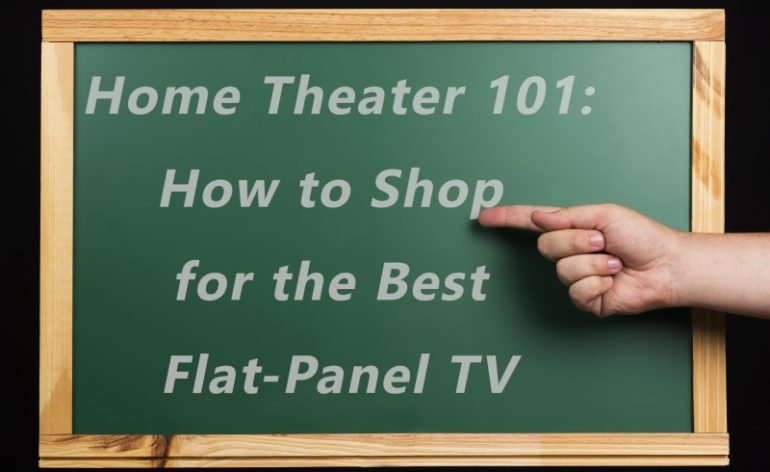Home Theater 101: How to Shop for the Best Flat-Panel TV
When shopping for a flat-panel TV, it’s hard to know what is best. The world of flat-panel displays can be very confusing. Just stepping into a big-box store and looking at the wall of TVs can be daunting. There are so many of them and they all look…exactly the same.
We know. We feel the same.
So you start to look at the prices. When you can’t tell the difference between the quality of the thing, maybe the price will tell you something. But how can one 65″ 4k TV cost 5x’s as much as another but look dimmer somehow? What are you missing?
Honestly, you are not alone here. We are experts and when we walk into these stores we get overwhelmed. So, let’s break down how to shop for the best flat-panel TV for your home.
Types of Flat-Panel Displays

There are currently two flat-panel TV technologies on the market – OLED and LCD. Don’t worry about the marketing around the technologies, if it doesn’t say OLED, it is LCD. We’ve talked about this before, so let’s quote ourselves like some sort of weirdo:
At the foundation, there are currently two different TV technologies on the market – OLED and LCD. OLED stands for Organic Light-Emitting Diodes and LCD is Liquid Crystal Display. What is the difference?
At the heart of it is backlighting. LCD screens contain two parts, an LCD panel and a backlight. Think of the LCD panel as tiny windows with colored glass. They cannot create light on their own, so they need a light behind them to shine through. The TV creates the picture by opening and closing these windows to varying degrees to create the pixels of the correct colors. The light that is used behind the window is an LED light. Sometimes many LED lights. The quality and the number of lights can play a big difference in the quality of the picture. Today, many people are calling LCD displays with LED backlights, LED displays. Confusing? Yes. But just remember that they are all just LCD displays with LED backlighting.
OLED TVs are a self-emissive technology. The pixels in the OLED panel both create the light AND the color without needing a window or a backlight. This means that every diode in the panel can be turned completely off when needed. This is why OLED TVs have such a great reputation for black levels and contrast.
-Source AV Gadgets
So, when you see a flat-panel TV touted as LED or QLED or anything other than OLED, it is LCD with a different backlight. There is nothing wrong with any of these technologies, they are just different. As for cost, OLED is generally much more expensive than an LCD of the same size.
Shopping for a Flat-Panel LCD TV
When you shop for home theater speakers, we often recommend that you go out and listen to as many different brands and types as possible. Not so with TVs. Flat-panel 4k displays are one of the things you can buy sight unseen. They are fairly easy to measure and compare and there are a lot of websites out there doing it. With OLED displays…well there just aren’t that many of them and they are all pretty good. You could spend an hour or two and read reviews of about every model that is on the market.
LCDs, unfortunately, are a different thing entirely. There are TONs of them out there and review-centered websites are struggling to keep up. While you might not find a review of the exact model you want, you can usually find one of a model in the same line. Can you always extrapolate? No. But take a look at the specs of each TV. Do they look close? Do the numbers look more similar than dissimilar? It’s going to take a bit more work on your part (and maybe an email or two to reviewers and manufacturers), but you should be able to figure it out. But what specifically should you be looking for when shopping for an LCD TV?
Full Array Backlighting
The thinnest flat-panel displays will have what we call edge lighting. This is, as it sounds, light that comes in from the edge. And sometimes a single edge! If you are thinking that would make one side of the image brighter than the other, you are correct. But edge lighting isn’t bad if your 4k TV isn’t meant to do anything other than be thin and show the news. But if you want a quality TV, you’re going to want full array backlighting.
As it sounds, this means that the light is behind the LCD panel and covers everything. This ensures that every part of the panel can be just as bright as every other part. That’s great, but not enough. Because if there is only one light back there (as early LCDs had), the black levels suffer. As we said above, if the LCD panel is like a bunch of small windows, having a single light behind all of it means it is near impossible to get the panel completely black. The windows all get down to dark grey but never black. Early flat-panel displays (and some modern, low-cost LCD TVs) will allow light in around the frame of each of the windows. This is why you also want to look for…
Local Zones of Dimming

The best way to create great black levels is to simply turn off the backlight. Nothing gets darker than no light. This is how OLEDs get such great scores in black-levels. They are able to turn off each individual pixel. With LCDs, they set up local zones of dimming. This, again, is exactly as it sounds: They install a number of smaller backlights and divide them from the others. That way, if an area is meant to be black (think every space movie ever), they can turn that specific backlight off. The more local zones they have, the more granular control they have over this effect.
But it isn’t perfect. Back to the space movie example. If there is a field of black with a couple of very bright stars that look like pinpoints of light, LCDs struggle. Even the best 4k LCD TVs on the market will exhibit what we call blooming around these small bright points in a field of black. Blooming is when instead of a pinpoint of light, the light seems smeared around the point and the nearby black area looks more grey. This is because the local zone is illuminated and the light is bleeding through.
While we make it sound dramatic (and now that we told you about it you can never not see it), it isn’t something most people will notice. In a direct comparison to an OLED, the difference is pretty obvious, but in your home, we doubt many would notice. The thing to remember is that more local zones are better than fewer.
Specific Features Important to You
Lastly, you need to identify before you start shopping exactly the features that are important to you in a flat-panel TV. Backlighting and local zones are universal, but everything else is optional. Do you care about variable refresh rate and HDR (hint: if you don’t have a very new receiver, game console, or Ultra HD Blu Ray player, you don’t)? Is HDMI CEC what matters? Are you looking for a particular number of HDMI inputs, Audio Return Channel functionality, size, price? All of these things will be determined by your specific setup or use needs. If you don’t know about any of that, you can reach out to the AV Rant Podcast for guidance.
Claims of Quality
I once had a delivery driver pick up a TV that I had just finished reviewing. It was a major brand that, at the time, was fairly new to the market. It was a low-cost option and was quickly gobbling up the lion’s share of the marketplace.
He told me, “I pick up more of these for return than any other brand. I would never buy one of these.”
This took me aback. Was he right? Did he know something I didn’t? So I did a little digging. Turned out that all the major brands, including the one the driver would “never buy,” had the same return percentage rate. But with the one brand outselling the other brands three to one, of course they’d have a higher absolute number of returns. But their percentage was no different.
Some of these claims probably have merit. If you buy the bottom-of-the-line 4k TV, expect that they cut some corners to hit that price point. But what you really want to look at is not if a consumer had a problem, but if, and how quickly, the company rectified it. The fact that the driver was picking up TVs for returns was actually a good thing! If the company wasn’t making good, he wouldn’t have picked up many at all.
Conclusion
We are going to list some additional reading below. The key to shopping for a flat-panel TV is that you can pretty much do all of it online. Take your time, read multiple reviews, and make sure the TV you buy has the technology, quality, and features you want. While it might not have every bell and whistle, it will be the very best TV for you.
Further Reading:
Easy Trick to Buying the Right Size TV
Guide to Screen Burn-in and Image Retention
What is Bias Lighting and Do You Need It?
What is a QNED TV?


